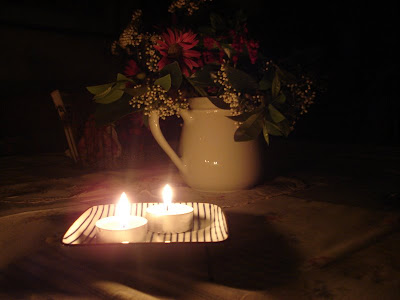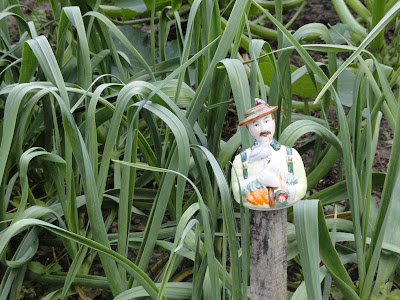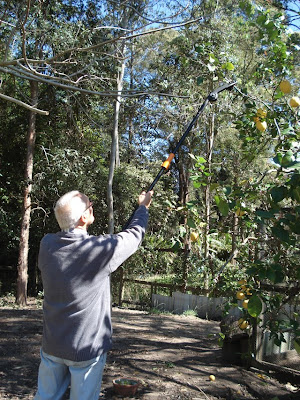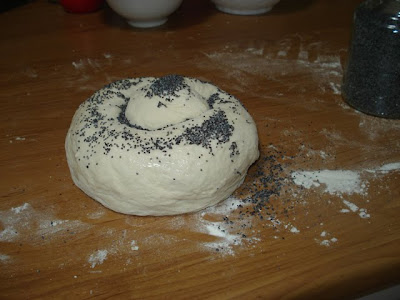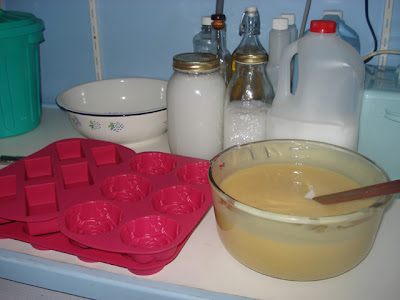I'd been thinking about it for a while and as Hanno was away last night I decided that it was time to have a no electricity night. I wanted to experience the candle light, and the silence, and see if I could knit and write by just the feint glow of candlelight. It was overcast all day so by 5.30 pm it was quite dark. I started getting my candles ready.
I'd already had a hot meal at lunchtime when my friend Susan visited. We had spinach pie and salad and lemon curd ice cream with fresh local strawberries. We washed it down with a delicious pear cider and later pomegranate juice mixed with mineral water. So I wasn't hungry but if I needed something the rest of the strawberries were on standby.
It felt strange to have the house slowly darkening.
I loved the ritual of lighting the candles and by the time all were aglow, the room looked wonderful. There was to be no music, no TV, no computer and no light. I didn't turn off the electricity because the fridge and freezer were still operating but I didn't turn anything on. I had one candle holder with a handle that I carried around with me so I didn't bump into the walls.
I took a few of the candles and placed them on the table near my knitting chair and sat there for about an hour, knitting. I didn't hear anything except at one point a train went by in the distance and I knew people were coming home from work in the city. I wondered what they would think of a woman sitting alone in a room lit only by candles, knitting away like it was the most normal thing.
Then I took about half an hour to write a letter using ink and paper. It was to an old friend of mine who doesn't have (nor want) a computer. I love using pen and ink to write, so this was very enjoyable. I could hear the pen scraping over the paper as the flickering candle shed golden light for me to write.

The photos are quite dark but it was easy to see around the room, even without the harsh light of an electric lamp. I amazes me now just how bright our normal nights are with much more light that we really need. I wonder what our ancestors would think of us now with extremely bright light available to most of us at the flip of a switch. My feeling is that some would love it and some would wonder what on earth we need all that light for.
I took a few of the candles and placed them on the table near my knitting chair and sat there for about an hour, knitting. I didn't hear anything except at one point a train went by in the distance and I knew people were coming home from work in the city. I wondered what they would think of a woman sitting alone in a room lit only by candles, knitting away like it was the most normal thing.
Then I took about half an hour to write a letter using ink and paper. It was to an old friend of mine who doesn't have (nor want) a computer. I love using pen and ink to write, so this was very enjoyable. I could hear the pen scraping over the paper as the flickering candle shed golden light for me to write.

The photos are quite dark but it was easy to see around the room, even without the harsh light of an electric lamp. I amazes me now just how bright our normal nights are with much more light that we really need. I wonder what our ancestors would think of us now with extremely bright light available to most of us at the flip of a switch. My feeling is that some would love it and some would wonder what on earth we need all that light for.
What I found in this exercise in self discovery:
- Knitting - easy, but I'd wouldn't have been able to fix a mistake if I made one.
- Writing a real letter was very enjoyable and it made me wonder why I don't do it on a regular basis. Emails are easier I guess and most people I know have computers.
It doesn't prove anything, it was just a little peek into a different reality, but well worth the time I gave it. I went to bed early and slept like a log. I figured that my pre-bed time was very relaxing and conducive to sleep. In any case I will do it again simply for the pleasure it gave me. There are people here who share this reality every night and I have to say your night time world is more beautiful than mine usually is. If you're like me and usually have at least one electric light on before you go to bed at night, have you done something like this? If not, why not try it. It would be a great activity to do with children. You could talk or play cards or board games while discovering the beauty a set of simple candles brings to a room.

